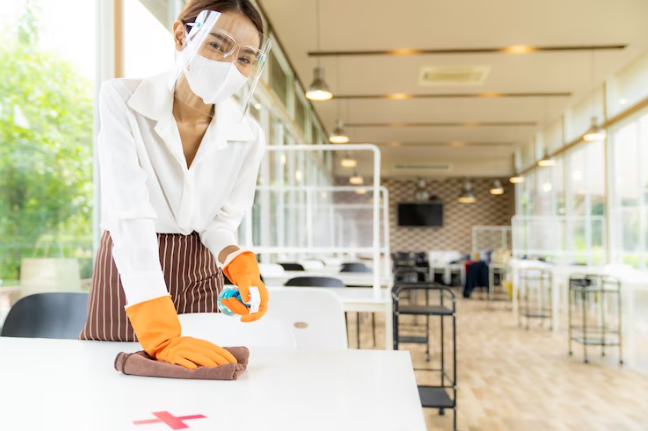When you dine out, you trust that the food you’re consuming is safe for consumption. As a restaurant owner or employee, it’s your responsibility to ensure that your establishment follows proper hygiene and food safety practices to protect your customers from foodborne illnesses.
This includes implementing strict protocols for handwashing, food storage, cleaning and sanitizing surfaces, pest control, and employee training.
By prioritizing restaurant hygiene and food safety practices, you can not only protect your customers, but also maintain a positive reputation and avoid legal consequences.
This article will provide an overview of the essential practices that every restaurant should implement to ensure the safety of its customers and staff. From proper handwashing techniques to employee certification programs, you’ll gain a comprehensive understanding of what it takes to run a clean and safe restaurant.

Handwashing and Personal Hygiene for Restaurant Staff
You need to make sure you’re washing your hands regularly and properly, using soap and warm water, to keep both yourself and the food you’re handling clean and safe.
Proper gloves should also be worn when handling ready-to-eat food, and nail care is essential for maintaining good personal hygiene in restaurants.
Keep your nails short and clean, and avoid wearing nail polish or false nails that can harbor harmful bacteria.
It’s important to remember that the hygiene practices of restaurant staff can have a significant impact on food safety.
The spread of illness-causing bacteria can be prevented by encouraging employees to stay home when they’re feeling sick and providing sick leave policies.
Health screenings can also be conducted to ensure that staff members are not carrying any infectious diseases.
By maintaining good handwashing and personal hygiene practices, you can help to prevent the spread of foodborne illnesses and keep your customers healthy and happy.
Proper Food Storage and Handling
When handling and storing food, it’s important to always use gloves and wash your hands frequently to prevent cross-contamination. But it’s not just about personal hygiene.
Temperature control is also crucial in storing and handling food. Raw meats, poultry, and seafood should always be stored at or below 40°F to prevent bacterial growth. Cooked foods, on the other hand, should be kept at or above 140°F to prevent the growth of harmful bacteria.
To prevent cross-contamination, it’s important to store raw meats, poultry, and seafood separately from ready-to-eat foods. Use separate cutting boards and utensils for raw and cooked foods. And always remember to wash your hands and sanitize surfaces after handling raw meats.
By following these guidelines for temperature control and cross-contamination prevention, you can ensure that the food you serve is safe and free from harmful bacteria.
Cleaning and Sanitizing Surfaces and Equipment
Maintaining proper cleanliness and sanitation of surfaces and equipment is essential for ensuring that harmful bacteria and germs don’t contaminate the food being prepared and served.
One way to do this is by regularly cleaning and sanitizing all surfaces and equipment that come into contact with food. Chemical disinfectants can be used to kill any remaining bacteria after a surface has been cleaned. However, it’s important to remember that not all disinfectants are safe for use on food surfaces. Be sure to read the labels and follow the manufacturer’s instructions carefully.
Another important aspect of maintaining cleanliness and sanitation is preventing cross contamination. This means keeping raw meats separate from ready-to-eat foods, using separate cutting boards and utensils for each type of food, and washing hands and surfaces thoroughly in between handling different foods.
Additionally, regular cleaning and sanitizing of kitchen tools such as knives, tongs, and spatulas is necessary to prevent the spread of harmful bacteria.
By following proper cleaning and sanitation practices, you can help ensure the safety of your customers and prevent the spread of foodborne illnesses.
Pest Control and Prevention Measures
Proper pest control measures are crucial to ensuring a clean and healthy environment for food preparation and service. Integrated Pest Management (IPM) is a proactive approach to pest control that involves a comprehensive strategy to prevent and manage pests. It’s a cost-effective and environmentally friendly method that focuses on long-term prevention rather than just reactive treatment.
Some of the elements of IPM include sanitation practices, exclusion, monitoring, and treatment. Inspection protocols are also an essential part of pest control and prevention. Regular inspections can identify potential pest problems before they become a serious issue.
Inspectors should look for signs of pests such as droppings, gnaw marks, and nests. They should also inspect food storage areas, equipment, and other areas where pests are likely to hide. By implementing a proactive approach to pest control and following inspection protocols, restaurants can maintain a clean and safe environment for their customers and employees.
Employee Training and Certification Programs
By investing in employee training and certification programs, you can ensure your staff is knowledgeable and skilled in restaurant hygiene and food safety practices.
These programs are designed to provide your employees with the necessary education to maintain proper food handling and storage procedures, as well as effective cleaning and sanitizing techniques.
Not only does training increase the effectiveness of your employees, but it also helps to maintain industry standards.
Certification programs are often recognized by health departments and regulatory agencies as meeting the requirements for food safety training.
By implementing these programs, you can demonstrate to customers and regulators that your restaurant takes food safety seriously and is committed to maintaining the highest levels of cleanliness and hygiene.
The Art Of Creating A Memorable Restaurant Ambience
Frequently Asked Questions
What are the most common foodborne illnesses and how can they be prevented in restaurants?
To prevent common foodborne illnesses, you should know the symptoms and take steps to avoid cross contamination. Symptoms can include nausea, vomiting, and diarrhea. Proper food handling, cooking, and storage can help prevent illness.
How often should restaurant equipment be deep cleaned and what is the best method for doing so?
To maintain equipment, clean frequently and use proper techniques. Deep cleaning should be done at least once a month or more depending on usage. Follow manufacturer instructions and use appropriate cleaning agents and tools.
What is the role of restaurant management in ensuring proper food safety practices are being followed by employees?
As a restaurant manager, it’s your responsibility to ensure effective training and employee accountability. This includes educating staff on proper food safety practices and enforcing compliance to prevent any potential issues or violations.
What are the legal consequences for a restaurant that fails to meet food safety regulations?
If you fail to meet food safety regulations, you may face legal consequences such as fines or even closure of your restaurant. Neglecting health hazards can put customers at risk and damage your reputation.
How do food safety practices differ between fast food and fine dining establishments?
When it comes to fast food vs. fine dining hygiene practices, there are some differences. Fast food restaurants tend to have more standardized procedures and employee training standards, while fine dining establishments may have more specialized training for their staff.
Conclusion
Now that you’ve learned about restaurant hygiene and food safety practices, it’s important to apply these principles in your daily operations.
As a restaurant owner or manager, it’s your responsibility to ensure that your staff is properly trained and knowledgeable about the best food safety practices. The health and safety of your customers should always be a top priority.
Remember to regularly inspect your equipment and facilities to ensure that they’re clean and in good working condition. Make sure that your staff knows the importance of proper handwashing and personal hygiene to prevent the spread of harmful bacteria.
By implementing these practices, you can build a reputation for providing safe and delicious food for your customers.



